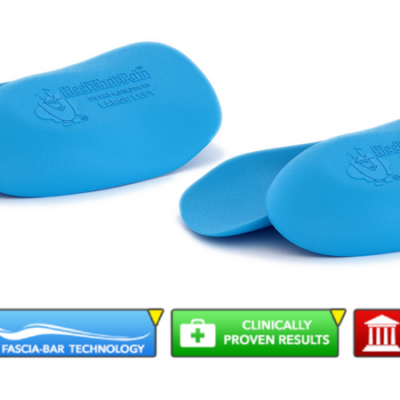Over Pronation (overpronation)
For such an uncommon word, overpronation describes a very common condition that affects millions of people — and can lead to heel pain, foot pain, and plantar fasciitis.
What exactly is overpronation? How can you tell if you overpronate when you walk or run? And what can you do about it?
Read on!
What Is Overpronation?
The word “pronation” simply refers to the way your foot moves while you walk or run. As your foot strikes the ground, your arch rolls inward slightly, stretches, and flattens to absorb and distribute the impact.
Overpronation, on the other hand, is an abnormal gait that can happen when the foot rolls too far inward — making it more difficult for your arch to absorb impact. This condition is especially common in people with flat feet or people with damaged arches.
Causes of Overpronation
There are several possible reasons why you might overpronate while you walk or run. If you suspect you might overpronate (more on symptoms, below!) identifying the cause can help you correct the problem. The following are some of the most common causes of overpronation:
Genetics
For some people, overpronation appears to be genetic and is present from childhood. However, keep in mind that according to the American Academy of Pediatrics, some overpronation is normal in very young children, since the arch of the foot doesn’t develop fully until about age six.
Flat Feet
Individuals who have very flat feet or a collapsed arch tend to overpronate. Flat feet can develop as a result of genetics, standing for long periods of time, or wearing unsupportive footwear like flip-flops or slippers.
Wear and Tear
Strain, overuse, and wear on the muscles, ligaments, and plantar fascia (arch) of the foot can cause the foot to flatten too much–and roll inward excessively–as it strikes the ground, leading to overpronation. A damaged arch is one of the leading causes of overpronation since a compromised plantar fascia can’t “spring back” properly or distribute impact effectively.
Unsupportive or Worn Footwear
Standing or walking in high heels for an extended period of time puts a lot of strain and pressure on the arch and surrounding ligaments and muscles. Along those same lines, shoes that don’t fit properly, don’t have any arch support, are worn out in the sole, or slide around while you walk can cause the arch to flatten and roll inward excessively.
Plantar Fasciitis and Heel Pronation
Normal pronation helps the arch distribute impact properly so that no one part of the foot is forced to absorb too much strain or pressure. However, problems with heel pronation can lead to plantar fasciitis over time as the arch flattens and breaks down.
While overpronation is usually the culprit when it comes to plantar fasciitis and heel pronation, some people suffer from underpronation, or supination, which happens when the foot doesn’t roll inward far enough. This condition is usually the result of high arches, rather than flat arches.
Symptoms of Overpronation
If you overpronate while you walk or run, you’re likely to notice pain in the arch of your foot and heel. You may also notice that your feet generally don’t feel very stable while you run–which can lead to stumbles or falls.
Overpronation also causes the foot to turn outward during movement at the ankle, which means that you are effectively walking along the inner portion of your foot. This strain and pressure along the instep can lead to heel and foot pain, as well as pain in the knees, back, and hips.
One of the biggest clues that will help you determine whether or not you overpronate is the wear pattern on your favorite pair of sneakers. Severe overpronation will show a lot of wear along the inner edge of the shoe’s sole, near both the toe box and heel. Moderate overpronation will show wear near the inner edge of the shoe’s sole at the toe box, and along the outer edge of the sole at the heel.
Treatment for Overpronation
One of the best ways you can treat overpronation is by wearing supportive shoes. Shoes should have ample support and cushion in the sole, particularly through the heel and arch of the foot. Without proper shoes, the arch of the foot is left susceptible to strain and flattening.
The symptoms of overpronation can usually be corrected and relieved through a heel-cup style orthotic insert with Fascia-Bar technology. The cupped shape helps to stabilize the heel while you walk or run, while the Fascia-Bar lifts and realigns the arch so that it can properly absorb and distribute impact. For overpronators who have developed heel spurs or plantar fasciitis, Heel Seats also offer soothing cushioning that holds up to a significant impact from walking or running.
If you’re wondering how much you pronate while you run, you can stop by most running shops to have your gait analyzed (often for free!). Don’t be surprised if you learn that your gait isn’t quite properly aligned–and take comfort knowing that simple solutions like proper footwear and orthotic inserts can help!







